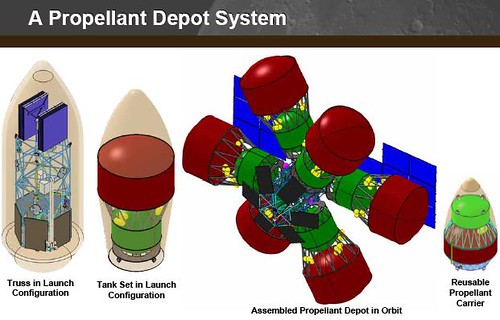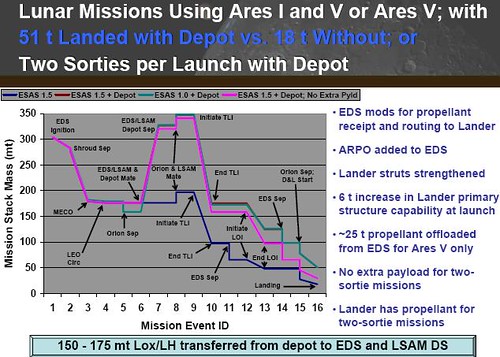Boeing has plans for a space gas station which would allow up to 15 times more payload to be sent to the moon in some missions. The system would allow for two to three times more payload for many missions. The system would also be able to leverage rockets that are three to five times cheaper than NASA ($10,000/kg) launch systems. Efficiently stocked gas stations and supply depots in space would make a huge difference to the cost and efficiency of space development. LEO gas stations supplied with $2000/kg [Russian Dnepr rocket] or cheaper rockets [SpaceX target of $500/kg] would make it cheaper for any rocket to get anywhere else. If fuel can be produced on the moon it has the potential to be cheaper to bring it out of a gravity well that is 6 times weaker than the earth’s gravity.

Boeing Propellant fuel depot
This kind of space infrastructure would make smaller and cheaper rockets far more capable of lunar development. I had proposed using a steady stream of inexpensive rockets to develop the moon using low energy orbital transfers to save on fuel. The low energy orbital transfer would require efficient ion drive space tugs for movement between LEO and the moon (or other destinations in space). However, bigger fuel savings would be possible with the fuel depot.
At a conservatively low government price of $10,000/kg in LEO, 250 MT of fuel for two missions per year is worth $2.5 B, at government rates.
Boeing’s plan is to build the depot in pieces like a stripped-down International Space Station, only in modules based on the upper stage of the Delta launch vehicle. Two depots would provide redundancy, each one with a total capacity of 175 tons of liquid oxygen/liquid hydrogen (25 tons for the lander, 125 for the rocket, with margins for boil-off and other contingencies). And while many of the necessary parts and operations (i.e., orbital cryogenic storage and transfer) still have to be developed and matured, they’re plausible—and critical for a space-faring civilization anyway.
Anyone can make propellant, and anyone can deliver it. The orbital reservoir will allow for different quantities from tanker vehicles both small and large. The payload itself is cheap, so even low-reliability launchers could potentially be used.
Boeing’s gas station could provide even more benefits than an improved lunar payload. Communications companies could improve their satellite payloads to geostationary orbit and beyond. NASA might be able to combine the dual launches in its moon program, or make its lunar landing vehicle reusable, with another depot using propellants produced on the moon. Because most of the mass necessary to get to the moon is propellant (though Boeing would never say so), a space gas station might even eliminate the need for a heavy-lift launcher altogether, increasing the launch rate of smaller, cheaper vehicles, which in turn could cut costs for getting to the moon and, eventually, Mars.
Examples of Propellant Depot Impact on Mission Performance
Current With Depot
Lunar Missions
• Landed mass 18 t 51 t
• Lunar surface payload: 2 t 35 t
• Sorties (with ESAS landed mass) 1 2
GTO mission (167 km x 35,788 km x 27°):
• Delta IV H: 13 t 35 t
• Atlas V 551: 9 t 23 t
GSO mission
• Delta IV H: 6 t 18 t
• Atlas V 551: 4 t 10 t
Interplanetary injection (C3 = 0)
• Delta IV H: 10 t 20 t
• Atlas V 551: 7 t 15 t
Commercial Propellant Depot Risks
– Cryo fluid management technology not matured
– SpaceX fails to successfully deploy Falcon 9
– Other customers fail to materialize
– Unable to sign long-term purchase agreement
– Lunar missions cancelled, delayed or reduced rate
– Maximum LEO price less than required for minimum ROI
– NASA opts to use Ares V as tanker; accepts less capability per mission and forgoes two-sortie mission

Steps to LEO Propellant Depot
– Mature cryo fluid management capability
– Successful Space Ex Falcon 9 development
[Cheap Russian and foreign rockets could be used like Dnepr]
– Mature business plan
– Long term propellant purchase agreements
– Continuation of lunar exploration/development plans
– NASA
– Bigelow Aerospace
– Shackleton Energy Company
– Successful depot system DDT&E

Brian Wang is a Futurist Thought Leader and a popular Science blogger with 1 million readers per month. His blog Nextbigfuture.com is ranked #1 Science News Blog. It covers many disruptive technology and trends including Space, Robotics, Artificial Intelligence, Medicine, Anti-aging Biotechnology, and Nanotechnology.
Known for identifying cutting edge technologies, he is currently a Co-Founder of a startup and fundraiser for high potential early-stage companies. He is the Head of Research for Allocations for deep technology investments and an Angel Investor at Space Angels.
A frequent speaker at corporations, he has been a TEDx speaker, a Singularity University speaker and guest at numerous interviews for radio and podcasts. He is open to public speaking and advising engagements.



Comments are closed.